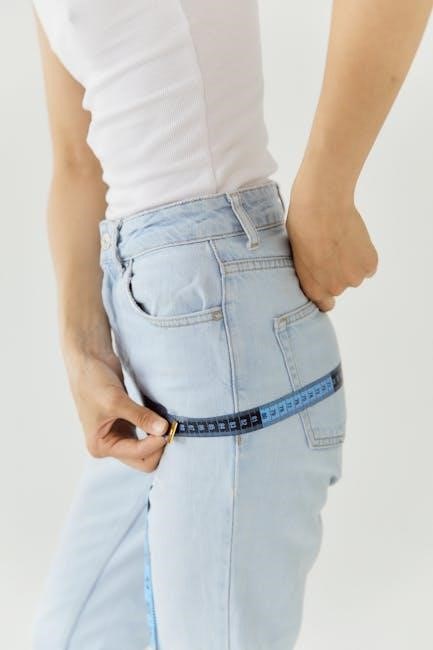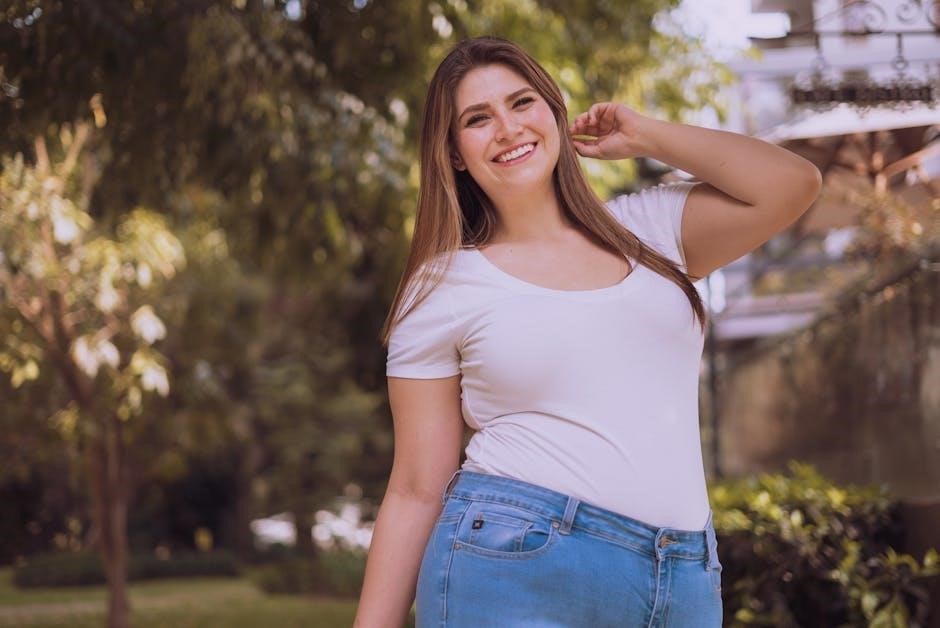A well-crafted women’s jeans size guide is essential for ensuring a perfect fit, addressing varying body types, and simplifying the shopping experience for all women.
1.1 Importance of Finding the Right Fit
Finding the right fit in women’s jeans is crucial for both comfort and confidence. A proper fit enhances your silhouette, improves mobility, and boosts overall satisfaction. Poorly fitting jeans can lead to discomfort, restricted movement, or an unflattering appearance. Understanding your measurements and using a reliable size guide ensures you select jeans that align with your body type, whether you’re looking for slim, straight, or relaxed styles. The right fit also prevents common issues like gapping at the waist or tight thighs, making it essential for a polished and comfortable look.
1.2 Evolution of Jeans Sizing Over Time
Jeans sizing has evolved significantly over the years, transitioning from basic “small, medium, large” categories to more precise numerical and alphabetical systems. Historically, sizing lacked standardization, often fitting inconsistently. Modern sizing incorporates detailed measurements, catering to diverse body types and styles. The rise of e-commerce and customer feedback has driven brands to refine size charts, ensuring better accuracy and inclusivity. This evolution reflects changing consumer needs and advancements in fit technology.

How to Measure Yourself for Jeans
Accurate measurements are key to finding the perfect fit. Measure your waist, hips, and inseam while standing straight, using a flexible tape measure for precise results.
2.1 Waist Measurement: Step-by-Step Guide
To measure your waist, locate your natural waistline, typically just above the hipbone. Wrap a flexible tape measure around it, keeping it level and parallel to the floor. Ensure the tape isn’t too tight or loose. Exhale naturally to get an accurate measurement. This step is crucial for determining the ideal jeans waistband fit, ensuring comfort and style. Record the measurement for reference when using size charts.
2.2 Hip Measurement: Accurate Techniques
Measure your hips by locating the widest point, typically 7-9 inches below your waistline. Stand straight and wrap the tape measure around your hips and buttocks, ensuring it’s level and not twisted. Keep the tape snug but not tight, exhaling naturally for an accurate fit. This measurement helps determine the seat and thigh fit of your jeans, crucial for comfort and style. Record it carefully for size chart reference.
2.3 Inseam Measurement: Ensuring the Perfect Length
Measure your inseam by standing straight and placing the tape measure along your inner leg from the crotch to your desired pant length. This ensures your jeans fit your leg length perfectly, whether you prefer ankle-grazing, mid-calf, or full-length styles. Accurate inseam measurements help avoid hemming or overly long hems, ensuring comfort and style tailored to your body. Record this measurement precisely for the best fit when using size charts.

Understanding Jeans Size Charts
Jeans size charts provide standardized measurements to help determine the best fit. They vary by brand and style, so comparing your measurements to the chart ensures accuracy and comfort.
3.1 Differences Between Numerical and Alphabetical Sizing
Numerical sizing uses measurements like 26, 28, or 30, often based on waist and inseam lengths. Alphabetical sizing, such as S, M, or L, is more subjective and varies by brand. Numerical sizing is precise, while alphabetical is relative, making it less consistent across brands. Both systems aim to fit diverse body types, but numerical sizing is often preferred for accuracy, especially when shopping online. Understanding these differences helps in selecting the most flattering and comfortable fit.

3.2 How to Read and Interpret Size Charts
Reading and interpreting size charts requires understanding the measurements provided, such as waist, hip, and inseam. Align your personal measurements with the chart to find your best fit. Consider fabric stretch and style differences, as these can affect sizing. Pay attention to customer reviews for insights on fit consistency. Double-check the chart for each brand or style, as sizing can vary. Using size filters effectively ensures a more tailored shopping experience online.
3.3 Variables Affecting Fit: Stretch, Fabric, and Style
The fit of jeans is influenced by fabric composition, stretch, and style. High elastane content offers more flexibility, while rigid fabrics provide structure. Skinny jeans hug the body tightly, while boyfriend styles offer a relaxed fit. Understanding these variables helps in selecting jeans that complement your body type and personal comfort preferences. Always consider fabric stretch and style when choosing sizes for the best fit.
Jeans Styles and Their Fit Characteristics
Jeans come in various styles, each offering unique fit characteristics. Skinny jeans hug the legs tightly, while straight-leg and boyfriend styles provide a looser, more relaxed fit.

4.1 Skinny Jeans: Measurements and Fit Tips
Skinny jeans are designed to fit tightly from waist to ankle, offering a sleek, form-fitting silhouette. To ensure the best fit, measure your natural waistline and hip circumference accurately. Opt for a size that allows freedom of movement without feeling restrictive. Pair high-waisted styles with longer tops for balance, and consider stretchy fabrics for comfort. Always check the inseam to avoid overly long or short hems, ensuring a polished look.
4.2 Straight-Leg Jeans: Classic Fit and Sizing
Straight-leg jeans offer a timeless, classic fit that suits most body types. They sit comfortably on the waist, with a straight cut from thigh to ankle, creating a balanced silhouette. Measure your waist, hip, and inseam accurately to find your size. Look for a fit that skims your legs without being too tight or loose. Pair with tucked-in tops to enhance the streamlined look. Consider fabric stretch for added comfort and mobility.
4.3 Boyfriend Jeans: Oversized Fit and Measurements
Boyfriend jeans are designed for an oversized, relaxed fit, offering comfort and a casual, laid-back style. They typically have a looser waist, a boxy silhouette, and a straight or slightly tapered leg. To find your size, consider allowing extra room in the waist and hip measurements compared to your usual fit. The inseam should align with your preference for length, whether cropped or full. Pair with fitted tops to balance the loose fit, and opt for stretch fabrics for added comfort and flexibility.

Body Types and Jeans Fit
Understanding your body type is crucial for selecting jeans that flatter your figure. Whether pear-shaped, hourglass, rectangular, petite, or tall, each body type has unique fit needs.
5.1 Pear-Shaped Body: Best Jeans Styles and Sizes
For pear-shaped bodies, high-waisted jeans and wide-leg or bootcut styles balance proportions, drawing attention away from the hips and thighs. Look for sizes that fit comfortably around the waist without gaping. A-line jeans are also ideal, as they skim over the hips. Ensure the inseam matches your leg length for a flattering fit. Avoid skinny jeans that accentuate the lower half. Opt for stretch fabrics for comfort and flexibility;
5.2 Hourglass Body: Balancing Proportions with Jeans
For an hourglass body, high-waisted skinny jeans or wide-leg styles work best, as they accentuate the waist and create balance. Look for jeans with a defined waistband to highlight your curves. Ensure the hips and thighs fit snugly without restricting movement. Avoid overly loose styles that hide your silhouette. Opt for stretch fabrics for comfort and a flattering fit. Choose sizes that complement your natural proportions for a polished, put-together look.
5.3 Rectangular Body: Finding the Right Fit
For a rectangular body, focus on creating curves and balancing proportions. Opt for boot-cut or flare jeans to add shape to the hips and thighs. High-waisted or mid-rise styles elongate the torso, while detailed pockets or embellishments can enhance the waist. Avoid overly loose fits, as they may overwhelm the frame. Ensure measurements align with your natural proportions for a flattering, tailored look that complements your body type.
5.4 Petite Body: Jeans Styles for Shorter Frames
Petite women should look for jeans with a shorter inseam or styles specifically designed for shorter frames. High-waisted or cropped jeans can create a balanced proportion, while slim or straight-leg cuts avoid overwhelming the frame. Ensure the waist fits snugly to avoid gapping, and opt for styles with minimal embellishments to maintain a streamlined look. Proper measurements are key to finding jeans that flatter and fit perfectly.
5.5 Tall Body: Jeans Styles for Longer Legs
Tall women benefit from jeans with longer inseams to accommodate their leg length. Styles like boyfriend, straight-leg, or flared jeans create balance and proportion. High-waisted designs can elongate the torso, while boot-cut or wide-leg jeans complement longer limbs. Ensure the waist fits comfortably to avoid gapping, and consider brands offering tall or long sizes for the best fit. Proper measurements are crucial to achieving a flattering, tailored look.

Fabric and Stretch in Jeans
Fabric composition and stretch significantly impact jeans fit. Higher elastane content offers flexibility, while cotton provides structure. Understanding fabric types helps in choosing jeans that match your comfort and style needs.
6.1 How Fabric Composition Affects Sizing
Fabric composition plays a crucial role in sizing accuracy. Materials like elastane add stretch, allowing jeans to adapt to body shapes, while rigid fabrics require precise measurements. Understanding fabric types helps determine how they will fit and move with the body, ensuring comfort and style. This variability highlights the importance of considering fabric when choosing sizes for the best fit.
6.2 Role of Elastane in Jeans Fit and Comfort
Elastane in jeans enhances fit and comfort by providing stretch and recovery. It allows the fabric to adapt to body movements and various shapes, ensuring a flattering fit. Higher elastane content offers more flexibility, while lower levels maintain structure. This blend ensures jeans stay comfortable throughout the day without sacrificing style, catering to diverse preferences for the perfect balance of stretch and support.

Common Fit Issues and Solutions
Addressing common fit issues like gapping waistbands, tight thighs, and uneven lengths ensures a more comfortable and flattering jean experience. Solutions often involve size adjustments or style changes.
7.1 Gapping at the Waist: Causes and Solutions
Gapping at the waist in jeans is often caused by a size that’s too large or a style unsuitable for your body type. To resolve this, ensure accurate waist measurements and opt for high-waisted designs or adjustable waistbands. Adding a belt can also provide a snugger fit. Choosing styles with stretchy fabric or a contoured waistband can further minimize gapping, ensuring a more comfortable and flattering silhouette.
7.2 Tight Thighs: How to Choose the Right Size
Tight thighs in jeans often result from sizing that’s too small or a style that lacks room in the thigh area. To avoid this, measure your thigh circumference and compare it to the size chart. Opt for relaxed-fit, boyfriend, or straight-leg styles, which offer more space. Fabric with stretch, like elastane, can also provide comfort and flexibility, ensuring a better fit without restriction.
7.3 Length Problems: Hemming vs. Buying the Right Inseam
Length issues with jeans can be resolved by either hemming or selecting the correct inseam. Hemming is a practical solution for jeans that are slightly too long, allowing for a custom fit. However, buying the right inseam initially ensures a perfect length without alterations. Measure your inside leg accurately, and refer to size charts to find jeans that match your leg length. This approach saves time and avoids the need for tailoring, providing a seamless fit straight from the purchase.

Shopping for Jeans Online
Shopping for jeans online requires accurate measurements, understanding size charts, and using filters effectively. Customer reviews and clear return policies ensure a confident and satisfactory purchase experience.
8.1 Using Size Filters Effectively
Using size filters effectively streamlines your online shopping experience. Start by knowing your measurements and referring to the size chart. Apply filters for your specific size range to narrow down options. Pay attention to numerical and alphabetical sizing differences across brands. This ensures you see only relevant results, saving time and reducing the likelihood of sizing mismatches. Combine size filters with customer reviews to make informed decisions and enhance your shopping efficiency.
8.2 Importance of Customer Reviews and Ratings
Customer reviews and ratings are invaluable when shopping for jeans online. They provide insights into fit, comfort, and sizing accuracy, helping you make informed decisions. Real experiences highlight how jeans perform in terms of stretch, fabric quality, and true-to-size fit. Pay attention to feedback about specific styles and sizes to avoid common issues like gapping or tightness. This enhances your shopping experience and increases satisfaction with your purchase.
8.3 Return and Exchange Policies: Key Considerations
When shopping for jeans online, understanding return and exchange policies is crucial. Look for retailers offering free return shipping and extended return windows, ensuring flexibility if the fit isn’t right. Check if exchanges can be made without additional costs. Clear policies reduce the risk of keeping ill-fitting jeans and build trust with the retailer. Easy return processes enhance overall satisfaction and encourage confident purchasing decisions.
A well-structured size guide empowers women to find jeans that fit perfectly, boosting confidence and satisfaction. It’s a comprehensive tool ensuring the best fit every time.
9.1 Recap of Key Points
Understanding your measurements, body type, and style preferences is crucial for selecting the right jeans. Refer to size charts for accurate fittings, and consider fabric stretch for comfort. Skinny, straight-leg, and boyfriend styles cater to different body types, while petite and tall options ensure proper length. Address fit issues like waist gapping or tight thighs by choosing the correct size or style. Online reviews and return policies can enhance your shopping experience, ensuring satisfaction.
9.2 Final Tips for a Perfect Fit
Always refer to size charts and consider fabric stretch for comfort. Check customer reviews for fit insights and use filters to narrow down options. Don’t hesitate to try multiple sizes or styles to find your best match. Pay attention to inseam lengths for ideal pant length. Return policies can provide peace of mind. Ultimately, prioritizing your body type and personal comfort ensures a flawless fit and a confident look.

Additional Resources
Explore our care guides for jeans, denim, and other fabrics. Find additional reading on body types, fit tips, and styling advice for the perfect look.
10.1 Care Guides for Jeans
Proper care ensures jeans last longer. Wash inside out in cold water to preserve color. Avoid bleach and fabric softeners. Air-dry or tumble dry on low. For stretch jeans, gentle cycles prevent loss of elasticity. Store folded or hung to maintain shape. Regular washing removes dirt, but over-washing can fade denim. Follow specific fabric care instructions for different materials, like pure cotton or blended fabrics, to maintain quality and fit.
10.2 Further Reading on Body Types and Fit
For deeper insights, explore resources dedicated to understanding body types and their ideal jean styles. Guides often categorize shapes like pear, hourglass, rectangular, petite, and tall, offering tailored advice. Learn how to measure accurately, interpret size charts, and choose fabrics that complement your figure. These resources enhance your understanding of fit, helping you make informed choices for a flattering and comfortable wardrobe.

